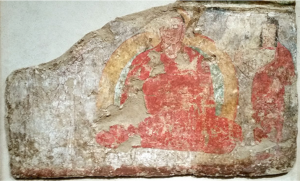
Once upon a time, a king in a far eastern land who owned great riches and had many wives, had no child who could be his heir. The king had even given away almost all his fortune as alms to generate merit in the hope of deserving a son. When he saw his fortune dwindling, the king traveled with his royal entourage to visit the Naga Queen and beg her for the precious wish-fulfilling gem to make his dream come true.
The Naga Queen listened to the king’s story and, out of pity, presented him with the gem he sought. On the way back to his kingdom in Oddiyana, the king passed a beautiful lake in which he could see all the sky and the mountains reflected, like a mirror. He stopped there to contemplate the view, feeling grateful. Suddenly, from out of the image of the sky upon the surface of the lake, the king saw with his naked eyes the tip of a lotus gently emerging, growing upward like the rising sun rising from the horizon. The king did not blink, and at once the blossom grew tall and strong, blooming fully in magnificent splendor with a thousand multicolored petals.
From the very center of the lotus a light as bright as a star appeared, illuminating all directions without limit or end. As the king did not blink, he was the first to see a young boy appear, standing and smiling as if they knew each other from eternity. Maybe they exchanged words? Maybe they talked about where each other came from? Or maybe there were no words at all because the moment was so magical and fantastic that there was no logical explanation for how this had happened or how this boy agreed to follow the king and be his longed-for heir? What they know, and what all the wives remembered as the king arrived home, is that he held in his arms a fully grown and charismatic young boy who could talk well and could even guess the names of all the women in the court. Everyone was surprised and happy with the magical arrival of the boy, who came to be known as Padmasambhava, the Lotus-born.
The boy grew well, but certainly he was not meant only to rule Oddiyana. He was special. He was certain that he would become the ruler of his own mind and live in freedom. He knew that he had come to show the way to all sentient beings—how they could also be the rulers of their own minds and set their existence free of mundane desires and suffering. When Padmasambhava felt the time had come for him to leave, he committed a very strange act that few people, or maybe none at all, understood at the time. He waited for the right alignment of the moon and planets as storm clouds massed on the horizon, then went up to the rooftop of the palace and began dancing with a trident. As he swung the trident in the air, lightning struck it and he let the trident fly straight into the breast of the minister’s son. The minister’s son was not a good man, although only Padmasambhava knew it, as he could see into the future how he would bring suffering upon many people, causing great disorder. Out of this knowledge and vision that no one else had, Padmasambhava acted, yet he also knew that it was time to leave, never to return.
Padmasambhava dwelled in what is today known as India, in company of many pilgrims, yogis, dakinis, and saints, visiting cemeteries and cremation grounds, sharpening his wisdom of life and death, fear and delusion, understanding well the underworld and heavens. In a short time, he was an expert in all tantras of that time, obtaining even more powerful siddhis, blessed and guided by powerful dakinis, and able to communicate in their secret language.
During his wanderings across the foothills of the Himalaya, Padmasambhava came to know of a princess who had been left by her father in a pit of thorns because she refused to marry any of the important men in his court. Mandarava prayed fervently and daily to be able to dedicate her life to the Dharma and not to married life. Somehow, Padmasambhava heard this prayer in his heart and, feeling her pain, realized that they shared the same heart and came to save her. Immediately they were connected by a love that transcended time and space. But when her father realized this, he ordered both of them burned on a pyre. It did not take long to witness that the fire of the angry king was nothing compared to the fire of Padmasambhava’s and the Princess Mandarava’s passion and transcendent love, which grew brighter as their bodies and souls were unified in clear light. The oil that the men threw on the pyre turned into water, forming a great lake. The light of the flames became soft, like that of a star, and from that light, all of the court witnessed the appearance of a blooming lotus flower at the center of which the two lovers embraced with their bodies intact. Even today, people can visit this famous lake, Rewalsar, in Mandi District, Himachal Pradesh, to offer flowers and butter lamps.

Mandarava became Padmasambhava’s spiritual consort and learned all the tantras with him, following the Dharma as she was meant to do. Some women visited Mandarava in her cave, where she spent most of her time meditating, asking for guidance. Once when the women told her they wished to be like her or otherwise be married to a beautiful man, she said:
“Each of you must examine your own mind to see how you have wasted your lives because of your needs and desires. Careless maidens, take hold of your minds! We women establish the seeds of samsara by craving ordinary pleasures. No matter how beautiful you are, your beauty and youth are illusory. Even minor illnesses can bring them down to lower status. Their minds and eyes are so spoiled that they cannot even see the need for precious Dharma! You could easily be persuaded and seduced by negative companions who would take you to hell. You would give up your bodies and even your lives for your husbands, but after some time you would lose control and begin to quarrel and fight incessantly and experience even greater suffering than the inhabitants of the envious god realm. The suffering of birth and death is beyond your imagination.
Consider the ways in which karma bears fruit. All the endowments and all the riches and possessions of this world are like an illusion or a dream, devoid of true existence. Beauty and endowments are like a rainbow disappearing into space. Even if they are present now, they can never be permanent. A marvelous nine-story palace adorned with the five precious jewels is, in itself, an illusion and a cause of downfall. Youth and beauty are like a summer flower, unable to withstand the onset of aging and destroyed by the first frost. Expensive silks and jewels are like dewdrops on the grass. Though present now, they disappear in an instant at the first strong wind. All the relatives, friends and attendants gathered together are like visitors to a market. One moment reunited, the next inevitably separated. The essence of your own life is like a candle trying to withstand a strong wind: there is no way to determine when it will go out, and it needs to be protected very carefully. Power and fame are like a roar of thunder in the sky: after listening for a moment, it becomes a useless echo. Anyway, all this has less essence than a handful of crumbs.”*
Padmasambhava continued to wander and teach the tantra of the Buddhist lineage through direct experience and full presence, radically transforming the lives of those he encountered. By that time he was well known by many . . . until his name was whispered to another far away king in a land called Tibet, the highest and perhaps the most dangerous kingdom of the known world. His name came from an important Indian scholar called Shantarakshita, who brought Buddhism to Tibet by the order of King Trisong Detsen (they say that this happened in the eighth century), but he was having tremendous difficulty teaching and consolidating the Dharma in Tibet, where people were wild, practiced magic against each other. Worst of all were the evil spirits who ruled the natural world, opposing the cultivation of consciousness, of wisdom, and of compassion. With no intention to destroy the angry forces, but rather to tame them and use their wrath to protect and preserve the Dharma, Padmasambhava, then also known as Guru Rinpoche, or precious teacher, was probably the only one who could do so. And so he was tasked by King Trisong and he accepted. Some say Padmasambhava remained in Tibet for 55 years, other say for 400 years. No one knows exactly, but what we do know is that he transformed that immense land, making the wild spirits vow to protect the Dharma. The first Buddhist monastery, Samye Ling, was built and the Dharma flourished and spread across the land.
Then the king introduced another princess to Guru Rinpoche. She was already a maid of high spiritual attainment and, before long, the famous Yeshe Tsogyal became his second consort and together they reached many levels of realization. It is told that when she saw Padmasambhava for the first time, she saw a universe within each of his pores, and inside each universe was the guru dancing in ecstasy, with infinite galaxies moving within each of his pores, bringing her all the memory of the origins, of no separation, and that she was part of him and part of all. Such realizations they were able to teach, but other teachings no one was able to perceive, so they hid these teachings for future generations. Those who find these precious teachings, called termas, are today called tertons. Yeshe Tsogyal was a real enlightened yogini who spent many years in isolated retreat. She accomplished several different cycles of tantric spiritual practice, such as Vajrakilaya, Zhitro, Tummo (inner heat), and Karmamudrā practice.
Nowadays, the most common image of Padmasambhava is with his two most famous consorts by his side: Mandarava and Yeshe Tsogyal, although he taught many others, including his 25 well-known disciples who attained a high level of liberation. Padmasambhava was responsible for bringing Buddhism to Tibet (and also to other countries, such as Bhutan and Mongolia) beginning with the Nyingma tradition, the oldest of the four main schools of tantric Buddhism.
Contemplating his fantastic story, Guru Rinpoche and all those whom he touched deeply, transformed, and liberated, can inspire each of us still today on a very personal level. He is considered a guru and also yidam (meditational deity) who lived in this world. His story is fantastical and, whether or not we believe it, there are many levels to understand it. Being born from a lotus on a still lake gives us an inner landscape of the possible conditions for our own mind. When the mind is still, it beautifully reflects all the universe just as it is, although the moment that it is disturbed, waves distort all images, generating confusion and delusions. And just as the still lake is where the lotus emerges; its roots deep in the muddy bed where the seed germinated, we can also think how magical it is that an unstained flower emerges, and how life itself is magical and miraculous, although we may take it for granted. The emergence of an awakened mind can come out of darkness because when there is no separation of good and evil, birth and death, past and future; the pure mind was always there. Perhaps the observer did not realize, but the original ground of pure essence is always available, like the sky.

The image of the guru in sexual union with his consort may cause some “disturbance” in the surface of the lake, because our minds are full of concepts that might limit our understanding to one only level of interpretation. And so it is with all tantric symbols, being each time more difficult to access its real meaning. If the guru is the infinite body of space (as you are and as I am) united with his beloved, charged with love, devotion, and wisdom (like the Earth, from whence we all come), we can understand it as the inner union of our own capacity for wisdom and compassion, space and energy, male and female, static and dynamic, with no separation from the image of the guru.
Images are keys, but not the actual experience. Image and appearance dancing in the winds of impermanence can be keys to remind us of the eternal infinity of the universe. The individual is like a pore in the body of the Divine, and the body of the individual has the Divine in each pore. As in sacred geometry, we learn that the image of the macrocosm is the same as the microcosm, when we grow infinitely inward, we grow infinitely outward. To know the universe, we shall look into ourselves and to know ourselves we shall look into the universe.
In order to touch such a depth of understanding, it is essential to be more intimate with symbolic language, as the literal limits the proximity of realization. Padmasambhava brought transformation in the way he moved, his energy, his penetrating gaze, and the myths and legends that followed his life, only for us to experience transcendence over the material dimension and perhaps to be touched by the fire of the urge he demonstrated for liberation. There are no shortcuts through words and facts. Words can be doorways, but once you pass through them, leave them behind; be silent, be open; burn and be reborn, dissolving in the lake of non-duality into an existence of symbols, of generous presence, of revolutionary love, of silent heroism, and of wise understanding.
“My father is wisdom and my mother is voidness.
My country is the country of Dharma.
I am of no caste and no creed.
I am sustained by perplexity; and I am here to destroy lust, anger and sloth.” ― Padmasambhava**
“All phenomena of samsara and nirvana are your own mind.” ― Padmasambhava**
* Translated from Portguese from the book in portuguese The Lives and Liberation of Princess Mandarava: The Indian Consort of Padmasambhava by Lama Chönam and Sangye Khandro.
** Advice from the Lotus-Born: A Collection of Padmasambhava’s Advice to the Dakini Yeshe Tsogyal and Other Close Disciples by Padmasambhava.
See more
Tiffani Gyatso
Yangchenma Arts & Music
Related features from BDG
Natural Radiance and the Outer and Inner Sun
Riding on the Back of Freedom: The Meaning of the Garuda
The Eyes of Liberation: Understanding Arya Tara
The Meaning of Mandalas












